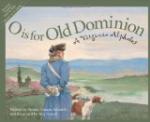Once ashore, Nautica and the Commodore found that a short walk along the river bluff brought them to an entrance to the Westover grounds. Gates of wrought iron, with perhaps a martlet from the Byrd coat of arms above them, swung between tall pillars in the wall. From this entrance, a pathway approached the homestead diagonally, and afforded charming views of the house and its surroundings. To our right as we walked, the lawn, thick set with trees, sloped gently to the river wall. To our left, the views came in broken, picturesque bits; a stretch of shrubbery, a reach of garden wall, some quaint outbuildings in warm, dull red, a glimpse of courtyard beyond a corner of box, and then the old home itself.
[Illustration: The hall, with its carved mahogany staircase.]
The riverward portal of Westover stands tall, white, and finely typical of its day. Above squared stone steps, the double doors with the fanlight above them are framed by two engaged columns supporting an elaborate pediment that has the symbolic pineapple in the centre.
We stood before the fine entrance, fancy painting the old-time scene within; that scene of eighteenth century elegance which is the traditional picture of colonial Westover. The door opened, and we entered upon perhaps quite as charming an eighteenth century scene, which is the Westover of to-day.
A panelled hall extended through the house, the double doors at the farther end opening upon a glass-enclosed vestibule. About midway, and from beneath a heavy crystal chandelier, the stairway of carved mahogany rose to a landing, where an ancient clock stood tall and dark, then turned and wound to the rooms above.
To the right of the hall was the drawing-room. Passing over its threshold, we thought of those old colonial days, the days of Colonel Byrd. As in his time, the light came subdued through the deep-casemented windows. It fell upon the walls that he had so handsomely panelled, upon the ceiling that he had ornamented in the delicate putty-work of his day, and upon furniture in carved mahogany that was of the period of his ownership of Westover.
At the farther end of the room was the noted mantelpiece imported from Italy by Colonel Byrd. It is an elaborate creation of Italian marble with relief design in white upon a black background. In front of it, on either hand, stood handsome brass torcheres, with their suggestion of the mellow candle-light that was wont to fall in this same room upon the courtly Colonel, the lovely Evelyn, and those brilliant assemblages of colonial times.
Opening also from the hall are the dining-room with its high colonial mantel and typical Virginia buffet, the French morning-room with its gray green tints and its touches of gilt, and the library with its old chimney-piece, high black fire-dogs, and quaint fire-tending irons. All the rooms have their colonial panelling, deep window-seats, and open fireplaces.




